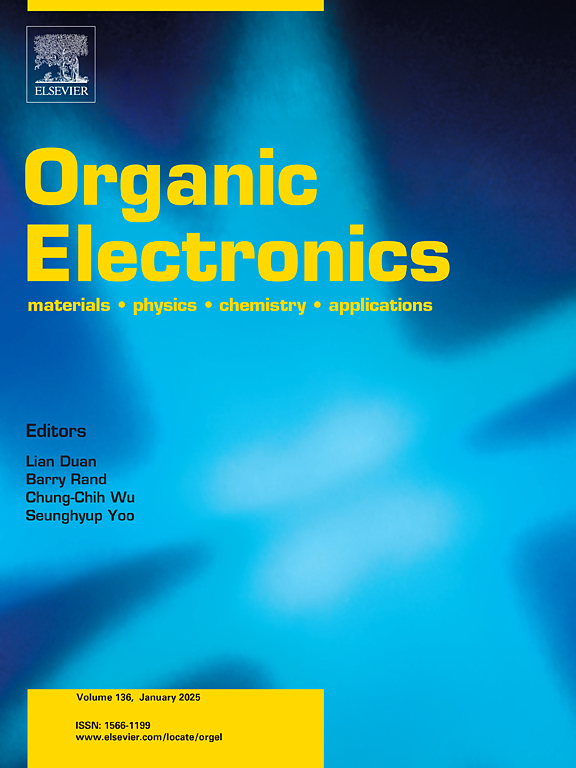Developed non-fullerene acceptors with modified BTPT-OD donor core: A DFT and TD-DFT methods to boost organic solar cell performances
IF 2.7
4区 工程技术
Q3 MATERIALS SCIENCE, MULTIDISCIPLINARY
引用次数: 0
Abstract
In this study, density functional theory (DFT) and time-dependent (TD) DFT were employed in order to conduct electronic structure predictions of four novel non-fullerene acceptors (NF2-NF5) generated from the recently synthesized acceptor BTPT-OD (NF1). We provided detailed information about charge transfer and optoelectronic properties of tailored structures, and we compared them to the reference compound. Compared to the energy gap of the reference molecule (2.09 eV), all developed molecules showed a smaller energy gap (2.00–2.08 eV). The created molecules, NF3 and NF4, exhibit high dipole moments of 8.902 D and 6.988 D, respectively, which may enhance the charge transfer rate. Maximum absorption of NF3-NF5 compounds (λmax, 686.7–694.6 nm) revealed a red shift in absorption as compared to the primary molecule NF1 (λmax = 676.9 nm). Based on the earlier research (J. Comput. Chem. 2023, 44, 2130–2148), we employed the recently modified Scharber plot to highlight the role of a narrower electronic gap in the proposed non-fullerene acceptors to enhance the power conversion efficiency. Among all tailored molecules, NF3 showed enhanced photovoltaic parameters; it exhibits a short circuit current density of Jsc = 11.34 mA/cm2, an open circuit voltage of VOC = 1.09 V, and a power conversion efficiency of PCE = 5.35 %, while reference molecule photovoltaic parameters are Jsc = 09.43 mA/cm2, VOC = 1.03 V, and PCE = 4.21 %.

开发具有修饰BTPT-OD供体核心的非富勒烯受体:DFT和TD-DFT方法提高有机太阳能电池的性能
本研究采用密度泛函理论(DFT)和时间依赖(TD) DFT对最近合成的受体BTPT-OD (NF1)生成的四种新型非富勒烯受体(NF2-NF5)进行了电子结构预测。我们提供了定制结构的电荷转移和光电子特性的详细信息,并将它们与参考化合物进行了比较。与参比分子的能隙(2.09 eV)相比,所有发育分子的能隙都较小(2.00-2.08 eV)。所制备的分子NF3和NF4具有较高的偶极矩,分别为8.902 D和6.988 D,这可能提高了电荷转移速率。NF3-NF5化合物的最大吸收光谱(λmax, 686.7-694.6 nm)较初级分子NF1 (λmax = 676.9 nm)发生了红移。基于早期的研究(J. Comput。化学,2023,44,2130-2148),我们采用最近修改的Scharber图来强调在拟议的非富勒烯受体中更窄的电子间隙的作用,以提高功率转换效率。在所有定制分子中,NF3表现出增强的光伏参数;短路电流密度Jsc = 11.34 mA/cm2,开路电压VOC = 1.09 V,功率转换效率PCE = 5.35%,参考分子光伏参数Jsc = 09.43 mA/cm2, VOC = 1.03 V, PCE = 4.21%。
本文章由计算机程序翻译,如有差异,请以英文原文为准。
求助全文
约1分钟内获得全文
求助全文
来源期刊

Organic Electronics
工程技术-材料科学:综合
CiteScore
6.60
自引率
6.20%
发文量
238
审稿时长
44 days
期刊介绍:
Organic Electronics is a journal whose primary interdisciplinary focus is on materials and phenomena related to organic devices such as light emitting diodes, thin film transistors, photovoltaic cells, sensors, memories, etc.
Papers suitable for publication in this journal cover such topics as photoconductive and electronic properties of organic materials, thin film structures and characterization in the context of organic devices, charge and exciton transport, organic electronic and optoelectronic devices.
 求助内容:
求助内容: 应助结果提醒方式:
应助结果提醒方式:


